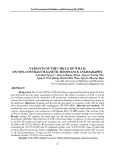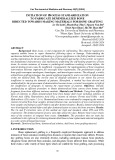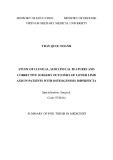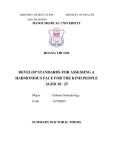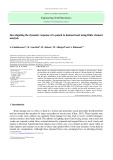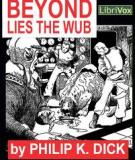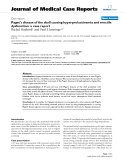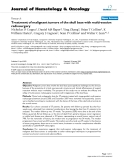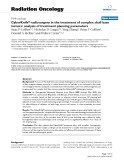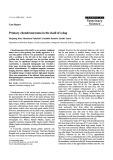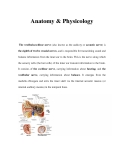
The skull
-
The Circle of Willis (CoW) distributes oxygenated blood throughout the brain and represents the only major anastomosis of the brain. The study of variations in CoW is crucial for avoiding confusion of the anomalies with aneurysms, evaluating collateral pathways in the intracerebral circulation, and enhancing pre-operative planning in patients undergoing surgery at the skull base.
 8p
8p  viakimichi
viakimichi
 17-01-2025
17-01-2025
 2
2
 2
2
 Download
Download
-
Bone tissue, a vital component for self-healing. This inherent regenerative capacity enables bones to repair themselves following injury or damage. Understanding the mechanisms behind bone tissue self-healing is of great significance in the field of medical research and has implications for the development of novel therapeutic approaches.
 7p
7p  vinara
vinara
 11-01-2025
11-01-2025
 1
1
 1
1
 Download
Download
-
Intracranial infection (abscess) - usually staphylococci or streptococci. Cranial surgery performed to open and drain abscess. Epilepsy - Cranial surgery to remove the epileptic focus for patients whose epilepsy cannot be controlled by drug therapy. Skull fractures - for depressed fracture or fracture with loose fragments. Cranial surgery necessary to elevate depressed bone and/or remove fragments.
 38p
38p  littledragon89
littledragon89
 10-08-2011
10-08-2011
 97
97
 25
25
 Download
Download
-
Surveying some clinical features and X-ray images of long bones, skulls, spine, blood biochemical tests and electrolytes in patients with Osteogenesis imperfecta. Evaluation of internal bone results using self-made tool to treat deformation of the lower limbs in patients with Osteogenesis imperfecta at Military Hospital 7 A.
 29p
29p  angicungduoc6
angicungduoc6
 21-07-2020
21-07-2020
 24
24
 2
2
 Download
Download
-
Description of the harmonious facial features of the Kinh people aged 18-25 in standardized images and skull x-ray according to the evaluation perspective of the professional council. Analyzing the perspective of the harmonious faces of the above research group according to the opinions of non-professional. Developing standards for assessing harmonious faces of the Kinh people.
 34p
34p  cothumenhmong6
cothumenhmong6
 17-07-2020
17-07-2020
 9
9
 1
1
 Download
Download
-
Head injuries are among the dangerous injuries which are common in all sport types. In the present study, the dynamic response of a punch to the head of a Wushu fighter was simulated by modeling the human head in ABAQUS software.
 10p
10p  tohitohi
tohitohi
 19-05-2020
19-05-2020
 17
17
 1
1
 Download
Download
-
Philip Kindred Dick (December 16, 1928 – March 2, 1982) was an American science fiction novelist, short story writer, and essayist. Dick explored sociological, political and metaphysical themes in novels dominated by monopolistic corporations, authoritarian governments, and altered states. In his later works, Dick's thematic focus strongly reflected his personal interest in mysticism and theology. He often drew upon his own life experiences and addressed the nature of drug use, paranoia and schizophrenia, and mystical experiences in novels such as A Scanner Darkly and VALIS.
 15p
15p  hotmoingay7
hotmoingay7
 23-01-2013
23-01-2013
 132
132
 6
6
 Download
Download
-
10 virus máy tính nguy hiểm nhất từ trước tới nay (Phần 3) .6. Nimda Virus Symbian Skull ảnh hưởng đến cả điện thoại di động, làm cho chúng hiển thị một loạt biểu tượng như trên Một virus khác xuất hiện trên Internet vào năm 2001 là worm Nimda. Nimda lây lan rất nhanh trên Internet, trở thành virus máy tính có tốc độ lây lan nhanh nhất thời điểm đó. Trong thực tế, theo TruSecure CTO Peter Tippett, nó chỉ mất 22 phút có thể vươn lên top danh sách các tấn công được báo cáo (nguồn Anthes). Mục tiêu...
 7p
7p  yeutinh98
yeutinh98
 26-09-2012
26-09-2012
 95
95
 6
6
 Download
Download
-
Tuyển tập báo cáo các nghiên cứu khoa học quốc tế ngành y học dành cho các bạn tham khảo đề tài: Paget's disease of the skull causing hyperprolactinemia and erectile dysfunction: a case report
 3p
3p  dauphong1
dauphong1
 21-12-2011
21-12-2011
 54
54
 2
2
 Download
Download
-
Tuyển tập báo cáo các nghiên cứu khoa học quốc tế ngành y học dành cho các bạn tham khảo đề tài:Treatment of malignant tumors of the skull base with multi-session radiosurgery
 11p
11p  toshiba24
toshiba24
 06-12-2011
06-12-2011
 72
72
 4
4
 Download
Download
-
Tuyển tập các báo cáo nghiên cứu về y học được đăng trên tạp chí y học Radiation Oncology cung cấp cho các bạn kiến thức về ngành y đề tài: " CyberKnife® radiosurgery in the treatment of complex skull base tumors: analysis of treatment planning parameters...
 10p
10p  toshiba10
toshiba10
 15-10-2011
15-10-2011
 56
56
 5
5
 Download
Download
-
Tuyển tập các báo cáo nghiên cứu khoa học quốc tế về bệnh thú y đề tài: Primary chondrosarcoma in the skull of a dog
 3p
3p  hoami_238
hoami_238
 17-09-2011
17-09-2011
 31
31
 2
2
 Download
Download
-
The vestibulocochlear nerve (also known as the auditory or acoustic nerve) is the eighth of twelve cranial nerves, and is responsible for transmitting sound and balance information from the inner ear to the brain. This is the nerve along which the sensory cells (the hair cells) of the inner ear transmit information to the brain. It consists of the cochlear nerve, carrying information about hearing, and the vestibular nerve, carrying information about balance.
 5p
5p  truongthiuyen2
truongthiuyen2
 10-06-2011
10-06-2011
 74
74
 2
2
 Download
Download
-
Skulls photographed by Eliot Goldfinger in the collection of the Department of Mammalogy at the American Museum of Natural History, New York: American bison, African buffalo, White-tailed deer, Caribou, Ox (neg. no. 603275); Bighorn sheep (neg. no. 603276); Mountain goat, Elk, Moose (neg. no. 603277). COURTESY AMERICAN MUSEUM OF NATURAL HISTORY LIBRARY
 13p
13p  audi123
audi123
 31-07-2010
31-07-2010
 166
166
 15
15
 Download
Download
-
Rabbit characteristics: Two pairs of upper incisors; second pair small and peg-like, located just behind the front pair. Perforated lace-like texture of bone on side of skull in front of eye socket. (Both features not found in rodents). Long and pointed large ears. Arched upper profile of skull. Strong extension of spine where neck vertebrae meet thoracic vertebrae. Strong extension of middle tail vertebrae, raising tufted tail. Relatively thin, delicate bones. Rear-projecting "metacromion" from lower end of shoulder blade (for insertion of trapezius and omotransversarius muscles).
 12p
12p  audi123
audi123
 31-07-2010
31-07-2010
 86
86
 12
12
 Download
Download
-
Short Neck Muscles The following three muscles are located on the back of the neck, just behind the skull: the obliquus capitis caudalis, the obliquus capitis cranialis, and the rectus capitis dorsalis major. They are covered by narrow and wide tendons and thin muscles, yet they help create the fullness on the back of the neck, determined in large part by the width of the atlas (the first neck vertebra) and the vertical projection of the axis (the second neck vertebra).
 10p
10p  audi123
audi123
 31-07-2010
31-07-2010
 115
115
 16
16
 Download
Download
-
Introduction The muscles of the head consist of the chewing muscles (temporalis, masseter, and digastric) and the facial muscles (zygomaticus, orbicularis oris, etc.). The chewing muscles are thick and volumetric, and they originate and insert on bone. They open and close the lower jaw, with the action taking place at the jaw joint (temporomandibular joint). The facial muscles are thin. They originate either from the skull or from the surface of other muscles, and they generally insert into other facial muscles or into the skin.
 14p
14p  audi123
audi123
 31-07-2010
31-07-2010
 156
156
 22
22
 Download
Download
-
Horse (equid) characteristics: One digit per foot ending in symmetrical, horny hoof. Walks on very tip of toe. Elongated skull; large lower jaw. Large upper and lower incisors. In side view, neck widens as it approaches shoulder (elongated triangular shape). Mane present, upright on wild species. Tuft of hair often present on forehead ("forelock"). Rear profile of neck straight or arched. Pointed, upright ears. Long, slender limbs.
 8p
8p  audi123
audi123
 31-07-2010
31-07-2010
 70
70
 10
10
 Download
Download
-
Giraffe characteristics: Very tall with long neck (elongated neck vertebrae) and long limbs. Bony prominences of neck vertebrae can be seen on the surface; brachiocephalicus and omotransversarius muscles, which usually cover the neck, begin low on the side of the neck, rather than up at the skull and first neck vertebra. Back line slopes downward toward rear. Usually three, permanent, bony "horns" in both male and female, covered with skin and fur.
 12p
12p  audi123
audi123
 31-07-2010
31-07-2010
 116
116
 15
15
 Download
Download
-
Dog (canid) characteristics: Anatomy is the same in various domestic breeds and wild species—major difference is size and proportion (Dachshund to Great Dane). Typically with elongated skull—snout long and narrow (some domestic breeds have short muzzles). Large canines. Cheekteeth with sharp edges for shearing. Large, pointed ears—upright in all wild species and in many domestic breeds; hanging in some breeds. Deep chest (top to bottom); long, thin limbs. Five digits on front limb (thumb reduced), four on hind limb (big toe absent). Blunt, nonretractile claws. Walks on toes.
 11p
11p  audi123
audi123
 31-07-2010
31-07-2010
 82
82
 15
15
 Download
Download
CHỦ ĐỀ BẠN MUỐN TÌM








